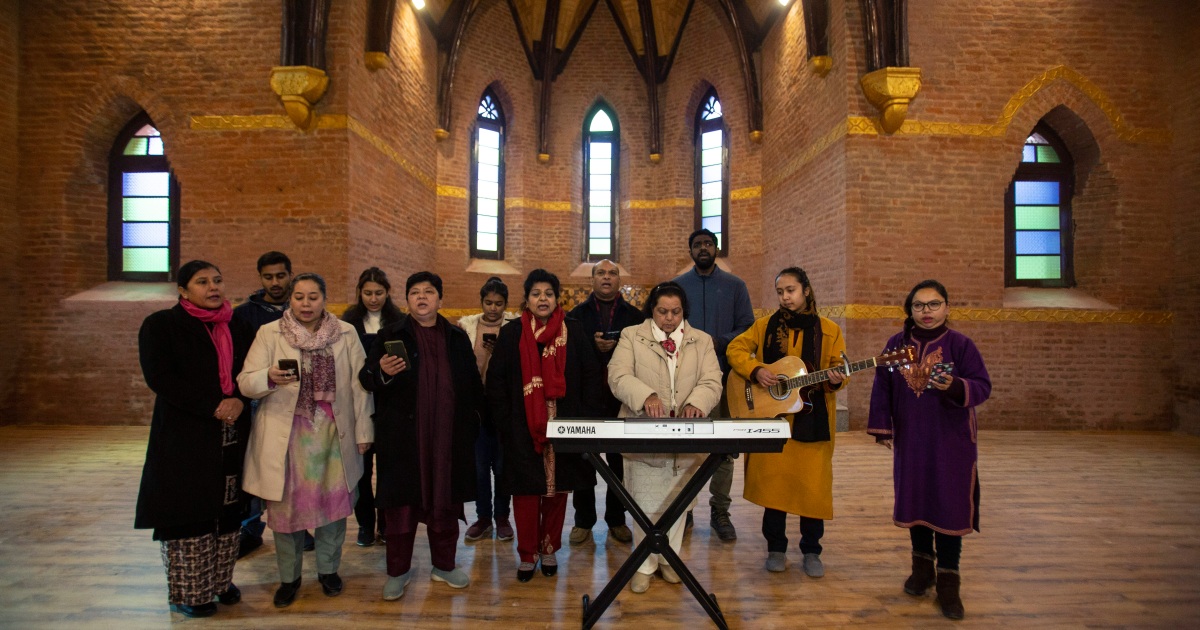
Saint Luke’s church in the main city of Srinagar holds prayers for the first time in nearly 30 years.
Srinagar, Indian-administered Kashmir – For the first time in three decades, a 125-year-old church in Indian-administered Kashmir reverberated with traditional bells and religious songs.
Ahead of Christmas, nearly a dozen Christians gathered at Saint Luke’s church in the disputed region’s main city of Srinagar on Wednesday – a day before the church was officially opened to the public.
For the region’s small Christian community, the reopening of the church – situated on the foothills of a hillock overlooking a Hindu temple in Srinagar’s Dalgate area – is a dream turning into reality.
“We have been working hard for the last many years and asking the government to open it. It is now a dream come true,” Reverend Eric, the priest in charge of the church, told Al Jazeera.
The church was closed in the early 1990s when an armed rebellion against Indian rule started in the Muslim-majority region, which is at the heart of a decades-old dispute with neighbouring Pakistan.
Kashmir is divided between India and Pakistan who rule over parts of it but claim the region in its entirety. Since their independence from the British rule, the two nuclear-armed nations have fought two of their three full-scale wars over the region.
In a place that sees violence every day, the historic church has become a new social media attraction. A large number of Kashmiri youth, including social media influencers, were seen posting pictures of the church on Twitter and Instagram.
Kashmiri boys walk past the 125-year-old Saint Luke’s church in Srinagar [Mukhtar Khan/AP]
Kashmiri Muslims have welcomed the church’s reopening.
“It was deserted for so many years. But now we are happy that this place will witness prayers again. It will strengthen the interfaith bond among communities,” Farooq Ahmad Gilkar, 66, who is a mason by profession, told Al Jazeera.
“This place was surrounded by bushes and creepers like a haunted place. We are delighted it will be lively again.”
Built by the Missionary Society of England, the historic church boasts of Gothic style colonial-era architecture.
“It was built by Kashmiri masons who specialised in clean brick and stonework,” Gilkar said.
The church is close to the Hindu Shankaracharya temple and lies less than a kilometre (mile) away from the shrine of Muslim Sufi saint, Syed Yaqoob, depicting the diverse culture of the Himalayan region.
A foundation stone at the centre of the church’s entrance says it was built by British doctors Dr Arthur Neve and Dr Ernest Neve. “To the glory of God and as a witness to Kashmir, dedicated by the Bishop of Lahore, September 12 1896,” says the inscription.
For years, the local Christian community – numbering about 35,000 in the region of 12 million people – had been demanding the church’s renovation.
Last year, the government decided to renovate it under the federal Smart Cities project, which seeks to restore historical buildings and religious places in Srinagar – home to more than a million people.
The renovation work at the church, where weeds and creepers had closed its entry, was affected by the coronavirus pandemic.
Kashmiri masons work at the entrance of the historic church [Mukhtar Khan/AP]
The Neve brothers were among the pioneers of modern medicine in Kashmir and introduced vaccinations for cholera and smallpox in the Himalayan region in the late 19th century.
For nearly 50 years, the two British doctors provided medical services at Kashmir Mission Hospital, established by them in 1888.
It is on the premises of this hospital, that the church was built by the Neve brothers. Today, their hospital is known as the Chest and Disease Hospital.
Muhammad Saleem, one of the contractors involved in the renovation of the church, said they tried to keep its original shape by using specialised wooden work, locally known as “khatamband”.
Dozens of workers fixed its wooden tiles on its floor, hand-engraved stones near the entrance and the colourful glasses on the windows as they did the final touches before Christmas.
The floor, ceiling, and roof of the church have been replaced. The old green-painted walls have been removed and replaced with red bricks.
“We wanted to keep the same look and we took help from old workers. We looked for the rare hands who are still able to do the work that was done a century ago,” Saleem told Al Jazeera.





